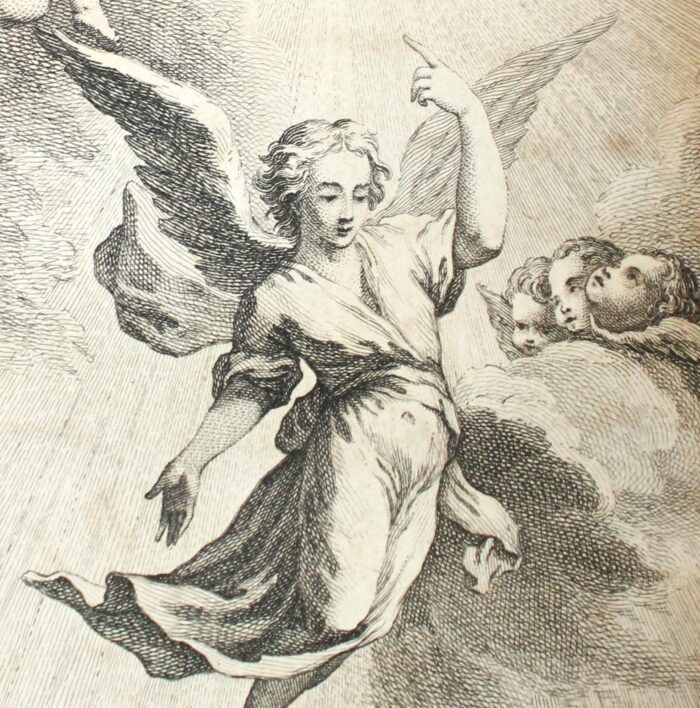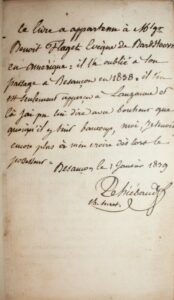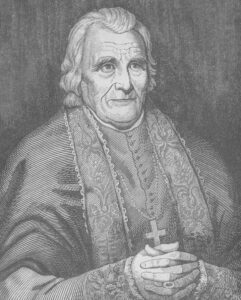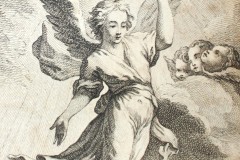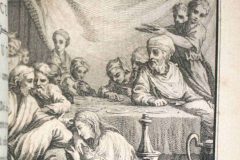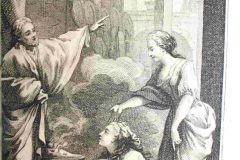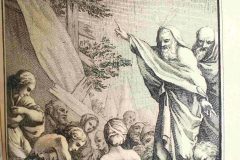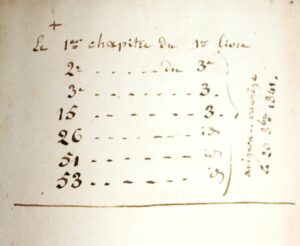[Thomas a. Kempis]. De Imitatione Christi. Libri quatuor, Ad Manuscriptorum ac primarum editionum fidem castigati, & mendis plus sexcentis expurgati. Recensuit J. Valart, Acad. Amb. Dissertationemque de ejusdem operis auctore addidit. Nova editio. Paris, J. Barbou, 1764. In-12. XI, [1], 417, [3] pp. Frontispiece and 4 intaglio out text by Longueil after Mariller, publisher’s mark on title page, headbands, lamp-ends. Early 19th century full black chagrin, triple cold fillet on covers, 4 ribbed spine decorated with cold fillets, gilt title, gilt fillet on edges, inner gilt roulette, all edges gilt.
Handwritten provenance mark on the front side of the frontispiece : “Ce livre a appartenu à Msgr Benoit Flaget, Evêque de Bardstooyn en Amérique : il l’a oublié à son passage à Besançon en 1838. il s’en est seulement apperçu à Lauzanne et là jai pu lui dire avec bonheur que quoiqu’il y tint beaucoup, moi, je tenais encore plus à m’en croire dès lors le possesseur. / Besançon, le 21 janvier 1839 / Thiébaud / Ch. Secret.” [This book belonged to Msgr Benoit Flaget, Bishop of Bardstooyn in America: he forgot about it when he came to Besançon in 1838. he only noticed it in Lauzanne and there I was able to tell him happily that although he was very fond of it, I was even more fond of believing myself to be its possessor from then on / Besançon, 21st January 1839 / Thiébaud / Ch. Secret]
Benoît Joseph Flaget was born in Contournat, near Clermont-Ferrand, on 7 November 1763. Ordained on 1 June 1788, he was a Sulpician priest, taught theology in Nantes for 2 years, and ran a seminary in Irrite, Anjou, until the revolution. He went to America as a missionary in 1792, to Fort Vincennes in Indiana, where he helped to spread Catholicism. He is quoted as saying: « Un missionnaire américain doit être capable de se nourrir de rien et de le cuisiner lui-même. » [ An American missionary must be able to eat nothing and cook it himself.] He then taught at Georgetown University from 1795 to 1798. After a stay in Cuba from 1795 to 1798, where he contracted yellow fever, he returned to Baltimore and was appointed Bishop of Bardstown (Kentucky) in 1808, becoming the second Bishop of the United States of America. The Diocese of Bardstown was the largest diocese ever formed in the United States, covering an area of 10 states, including Kentucky, Ohio, Tennessee, Michigan and Indiana. Today, this sector comprises 35 dioceses. He died on 12 February 1850. His body rests in the cathedral of Louisville (Kentucky), where he was bishop from 1841 until his death.
Victor Joseph Thiébaud (September 4th 1799 Pontarlier – 1892 Besançon) was ordained priest in 1822, parish priest of Ougney until 1829, assistant secretary to the archbishop around 1830, then head of the secretariat. He became a full member of the chapter in 1844. A colourful and controversial figure, he was a man with a facile pen, a formidable pamphleteer, and above all fuelled the liturgical controversy to defend Roman ideas against the Gallican opinions of Cardinal Mathieu, Archbishop of Besançon. There are no fewer than 27 controversial works, including Crise nouvelle du bisontinisme agonisant, Besançon, 1864, in-8°. (M. Roche – Michel Vernus : Dictionnaire biographique du Département du Doubs, Arts et littératures, Lons-le-Saunier, s.d. [1997 ?], pp. 460-461 ; Emile Fourquet : Les Hommes célèbres et les personnalités marquantes de Franche-Comté du IVe siècle à nos jours, Besançon, Séquania, 1929, p. 423)This edition, proposed by Abbé Valart in 1758, was a great success: it was reprinted 4 times in twenty years (1760, 1764, 1774, 1778); the work contains extracts from Fontenelle and Leibniz on the back of the title, a preface, 4 pages of prayers, a table, a dictionary of Latin words whose meaning differs from that of the classical authors, an index, a catalogue of the prayers contained in the work, a ‘Dissertation on the author of the Imitation, revised & considerably expanded’ (pp. 385 to 417), and ‘passages taken from the books of the Imitation, from which we can learn a few things about the Author’. Printed with the typeface of M. Fournier le jeune.
Our text was followed by Didot in 1789 and by Bodoni in 1793, in his luxury edition. ‘Abbé Valart [Frévent 1698-1781] appended to his edition a French dissertation on the author of the Imitation, which is entirely in favour of Gersen. It is against this dissertation that are directed those of P. Géry, abbé de Sainte-Geneviève, printed in 1758, in-12; of the abbé Ghesquière, published by the abbé de Saint-Léger, in 1775, in-12; of P. Desbillons, at the head of the Latin edition of the Imitation, Mannheim, 1780.’ (Augustin de Backer, Essai bibliographique sur le livre de Imitatione Christi, Liège, L. Grandmont-Donders, 1864. p. 24). The question of the attribution of this work is still open. In his work De l’ « Imitation de Jésus-Christ », Paris, Cerf, avril 2002, Brian McNeil also supports the attribution of this anonymous text to Jean Gersen, a Benedictine abbot from the first half of the 13th century.
Cohen, 510 ; Backer, 386-392.
Handwritten note in another hand on the lower flyleaf giving book references and dated : « avignon-Maurèze / le 20 8bre 1841. »
Caps head leveled , covers rubbed and worn, slight wear to corners; wetness on frontispiece and 1st engraving. Good condition.
1 400 €
